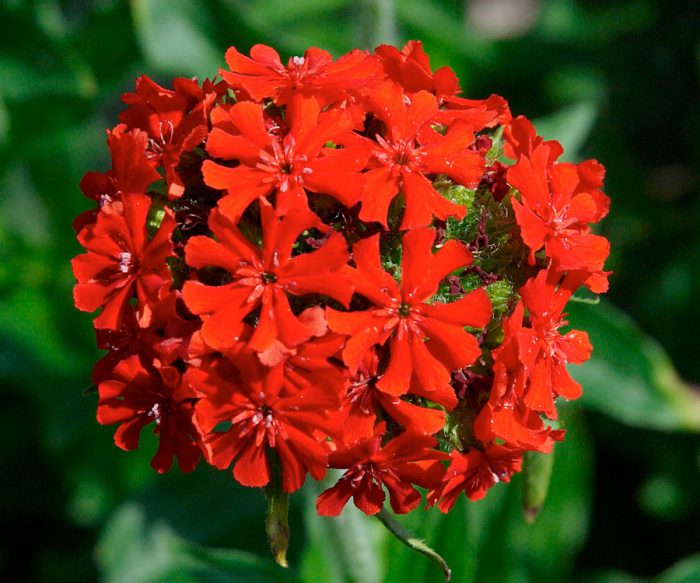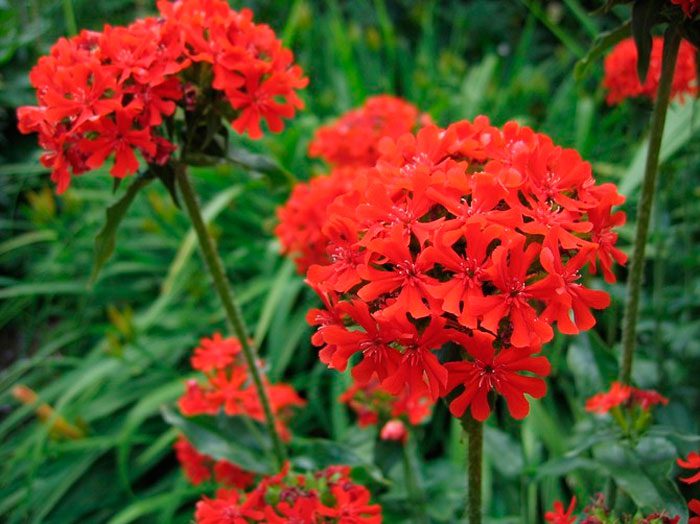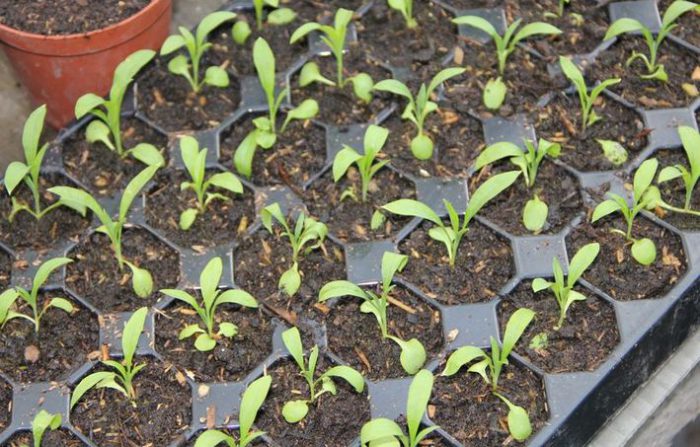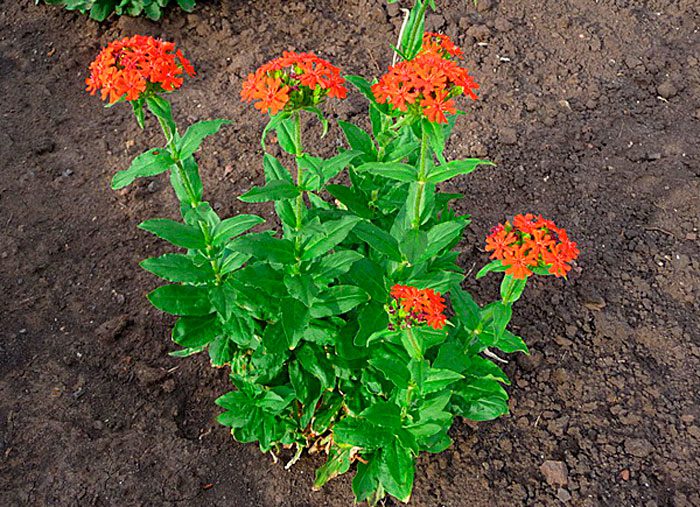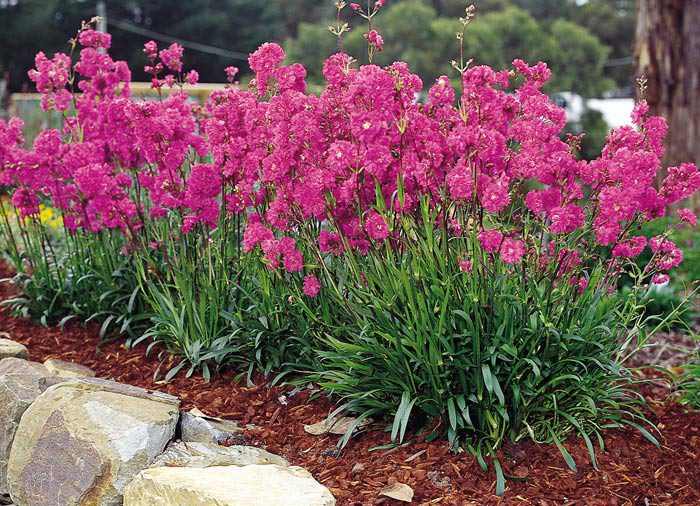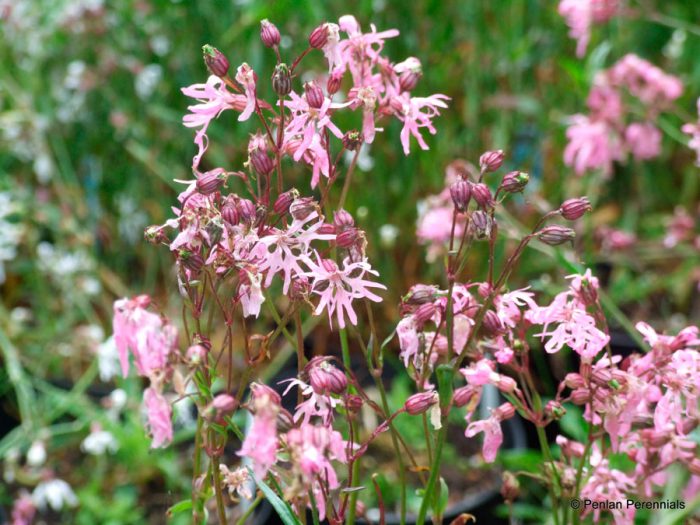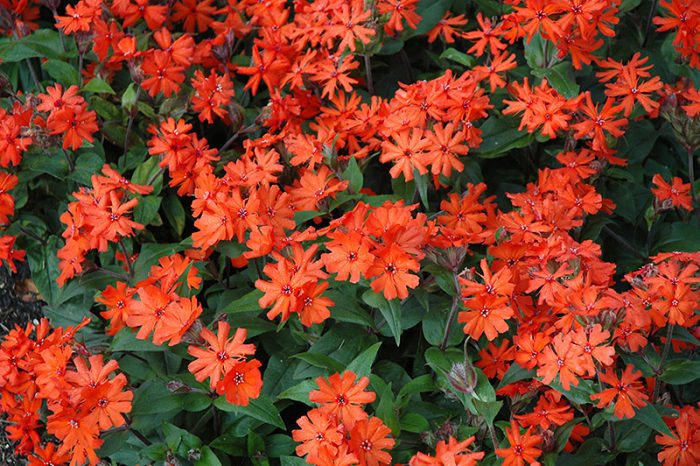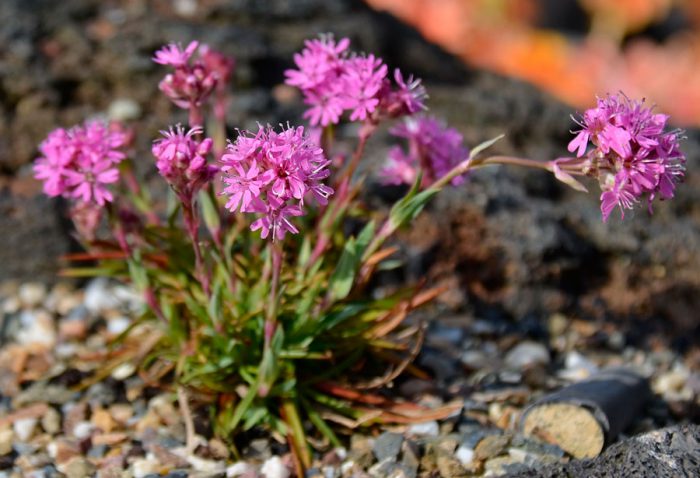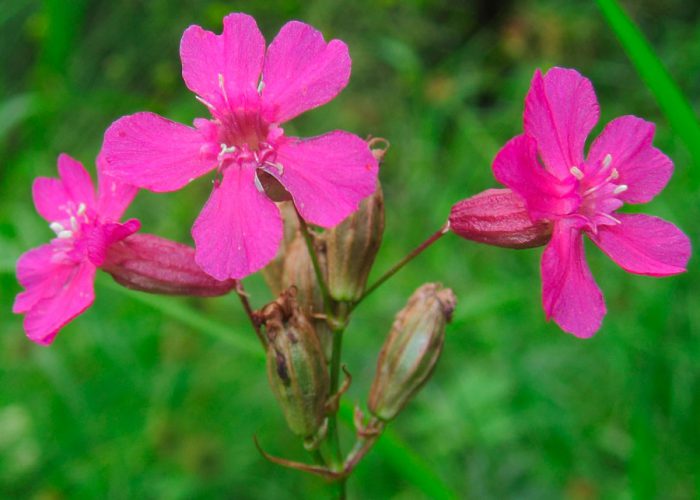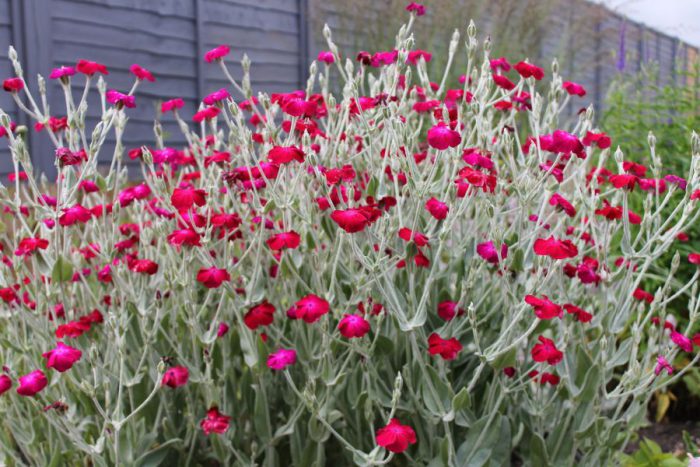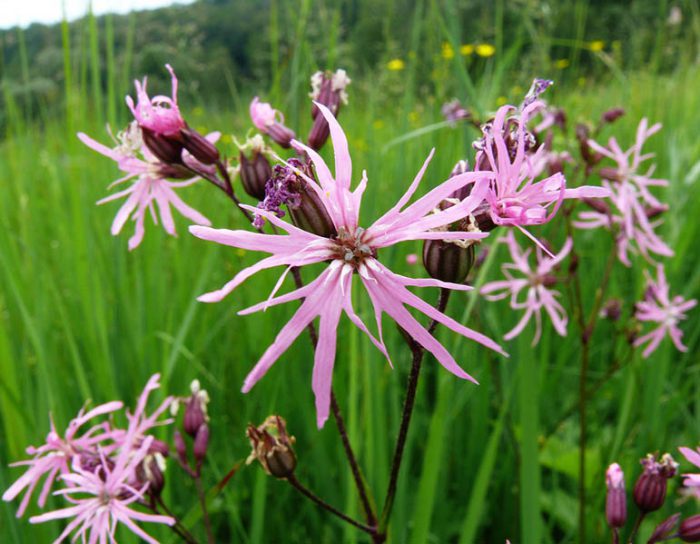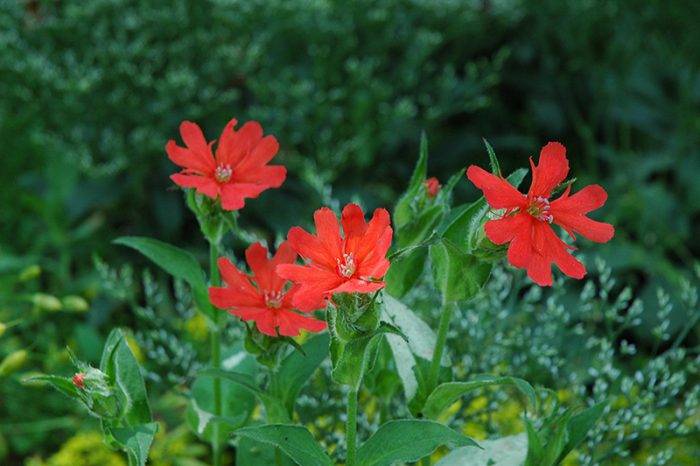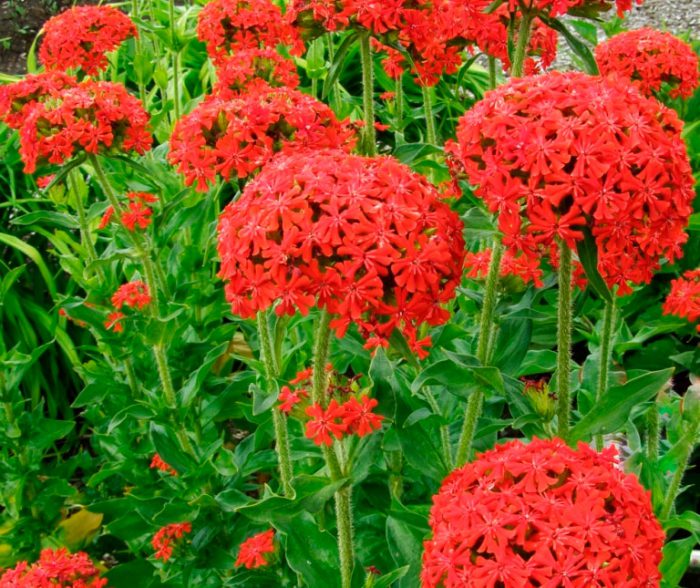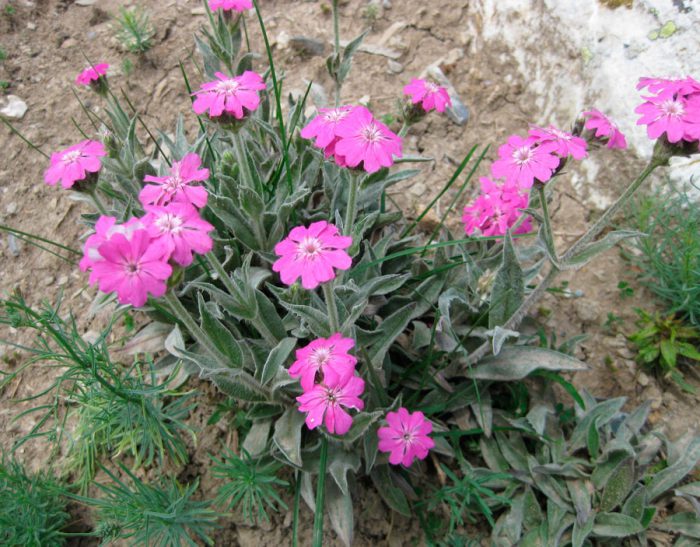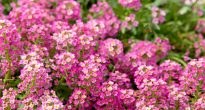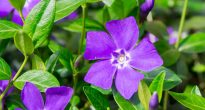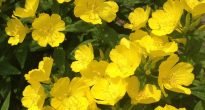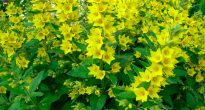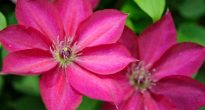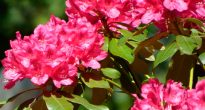Such a perennial plant as Lychnis (Lychnis) is a representative of the Clove family, but in some cases this genus is included in the Smolevka genus. The scientific name of such a plant comes from the Greek word that translates as "lamp". There is a version that this is due to the fact that lychnis flowers have a very rich color, or with the fact that in ancient times the foliage of one of the species was used as a wick. A mention of this flower can be found in the writings of Theophrastus. It has been cultivated since the end of the 16th century. According to information taken from various sources, this genus unites 20-50 species, in the wild, they can be found in the Northern Hemisphere. Only 15 species of lychnis are cultivated by gardeners.
Content
- 1 Lychnis features
- 2 Growing lychnis from seeds
- 3 Lychnis care
- 4 Types and varieties of lychnis with photos and names
- 4.1 Lychnis arkwrightii
- 4.2 Lychnis alpine (Lychnis alpina = Viscaria alpine = Steris alpine)
- 4.3 Lychnis viscaria (Viscaria vulgaris = Lychnis viscaria = Silene viscaria)
- 4.4 Lychnis crown (Lychnis coronaria = Lychnis coriacea)
- 4.5 Cuckoo adonis (Coronaria flos-cuculi), or cuckoo bloom (Lychnis flos-cuculi)
- 4.6 Lychnis sparkling (Lychnis fulgens)
- 4.7 Lychnis Haage (Lychnis x haageana)
- 4.8 Lychnis chalcedonica (Lychnis chalcedonica), or dawn
- 4.9 Lychnis Jupiter (Lychnis flos-jovis = Coronaria flos-jovis)
Lychnis features
Lychnis is a herbaceous rhizome plant that is a perennial. Its height can vary from 0.4 to 1 m. There are hairs on the surface of the stem; it is rounded in cross section. Sharp lanceolate-ovate semi-stem-embracing leaf plates sometimes have a heart-shaped base, and their seamy and front surfaces are rough. The heads or terminal scutes consist of bisexual flowers up to 20 mm in diameter, their dicotyledonous petals can be pink, white, deep red, pale yellow or deep orange. The fruit is a multi-root with kidney-shaped seeds of a dark brown color, reaching 0.2 cm in diameter, they remain viable for 3 or 4 years. Lychnis perennial can be grown in the same place for about 5 years.
Growing lychnis from seeds
What time to plant
Lychnis can be easily propagated by seeds, which are sown in open soil before winter or at the beginning of spring. For the first time, such a plant will bloom only next season, regardless of when you sow it. Very rarely, when sown before winter, under favorable weather conditions, flowering can begin in summer, but not in full force.
If you grow these flowers through seedlings, then they will bloom already this season. Before sowing seeds for seedlings in March, they should be stratified by placing them on a refrigerator shelf for 15-30 days. Crops must be harvested in a warm enough place (from 18 to 20 degrees). The first seedlings will appear a few weeks after sowing. Seedlings are planted in open soil in the last days of May, pre-hardened for 14 days. If you decide to sow seeds directly into open soil, then you need to do this in April ― June.
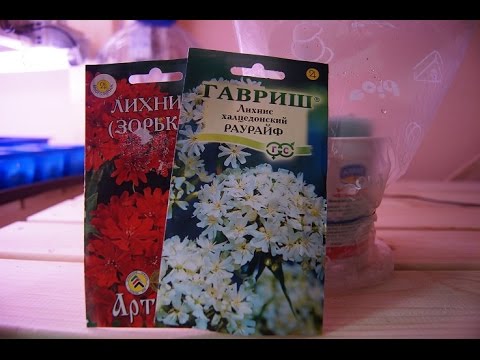

Watch this video on YouTube
Landing in open ground
This flower is not particularly demanding on growing conditions. For planting it, you should choose a sunny area with nutritious, well-drained and moderately moist soil. Lychnis crown grows well in shaded areas. Before proceeding with sowing seeds, it is necessary to add 1 bucket of river sand, 40 grams of potassium magnesium and 50 grams of superphosphate to the soil per 1 square meter of the plot. In clay soil, compost or humus should be additionally added. Before sowing, it is necessary to liming the soil if it is acidic. Before sowing, seeds should be refrigerated for 4 weeks so they can cold stratify. Pre-prepared seeds must be sown into the grooves, then they are sealed. Crops should be well watered. For friendly shoots to appear, the air temperature should be about 18-20 degrees. The first seedlings can be seen in 2.5–3.5 weeks.
Lychnis care
Lichnis, grown in the garden, needs to provide systematic watering, especially if there is strong heat. When the plant is watered, it is necessary to systematically loosen the soil surface on the site, while removing all weeds. Please note that such a flower can easily drown out weeds, in this regard, the future of this plant depends only on you. In order for the lychnis to bloom longer, it is necessary to promptly remove the inflorescences that have begun to fade, while pulling out all the plants that are trying to get to the area of the lychnis.
During the growing season during the season, such a plant should be fed only 2 or 3 times. Slightly grown and strengthened seedlings are fed with complex mineral fertilizer. Then such feeding is carried out 1 time in 15-20 days.
Diseases and pests
If such a flower is watered too abundantly or very often, then this can cause the development of rust, root rot and leaf spot. As a preventive measure, it is recommended to develop such an irrigation schedule, taking into account the weather characteristics of your region, so that no liquid stagnation occurs in the plant root system. If the first symptoms of the development of a fungal disease are noticed, then the affected specimen must be sprayed with a fungicidal preparation.
If leafworms or aphids settle on the bush, then to destroy them it is necessary to use a decoction of the tops of tomato or tobacco, into which you need to pour soap chopped with a grater. If there are too many harmful insects, then you can deal with them by treating the bush with an insecticidal agent.
After flowering
This flower does not require shelter for wintering, since it has a very high resistance to frost. However, if you grow terry varieties of lychnis, then they must be covered for the winter. After the yellowing and wilting of foliage and shoots begins, they must be cut to the base. Terry bushes, after they are cut off, should be covered with a layer of leaves, peat or dry soil.
Types and varieties of lychnis with photos and names
Below will be described those species and varieties of lychnis that are cultivated by gardeners.
Lychnis arkwrightii
The height of the compact bush varies from 0.35 to 0.4 m, shoots and narrow leaf plates have a burgundy color.The plant has a small number of inflorescences or single orange flowers, reaching about 30 mm in diameter, bloom at the ends of the shoots in the last days of June, while flowering continues until mid-August. The most popular variety is Lichnis Vesuvius: rich green leaf plates have a heart-shaped shape, the inflorescences are more luxuriant than that of the main species, they consist of red-orange flowers.
Lychnis alpine (Lychnis alpina = Viscaria alpine = Steris alpine)
In nature, this species can be found on the territory of the tundra and forest-tundra of Scandinavia, the eastern part of Greenland and North America, and also in the mountain-tundra and alpine belt of Europe. The height of a perennial bush is from 0.1 to 0.2 m. There are basal leaf rosettes, as well as several shoots on which there are opposite linear leaf plates. Panicle inflorescences consist of pink-red or crimson flowers. The most popular is the Lara variety: a lot of light pink flowers are revealed on the bush.
Lychnis viscaria (Viscaria vulgaris = Lychnis viscaria = Silene viscaria)
In nature, it can be found in Crimea, Central Europe, Ciscaucasia and in the south-west of Siberia. The height of the shoots of this herbaceous perennial plant is 0.4–1 m. Their upper part is very sticky, so this species is also called tar. White or crimson flowers, 5-7 pieces each, are part of the whorls that form panicles. Most popular varieties:
- Rosetta... The color of the double flowers is deep crimson.
- Lychnis terry flora Pleno... The height of the bush is about 0.3 m. The linear narrow basal leaf plates are dark green. The racemose inflorescences consist of double purple flowers, reaching 20–30 mm in diameter.
Lychnis crown (Lychnis coronaria = Lychnis coriacea)
The height of such a herbaceous perennial varies from 0.4 to 0.9 m. Loose racemose inflorescences consist of pink flowers, but there are also plants with white inflorescences. Popular varieties:
- Angels Blanche... The color of the flowers is dark pink, white or crimson.
- Mysterious Island... The center of the flower is pink, and along the edge of the petals there is a white border.
Cuckoo adonis (Coronaria flos-cuculi), or cuckoo bloom (Lychnis flos-cuculi)
This species is found naturally in most of Europe. Such a delicate flower forms a loose sod, which consists of rosettes and shoots branching in the upper part and reaching a height of 100 cm. The opposite narrow stem leaf plates gradually decrease in size as they approach the apex of the shoot. The scutes are composed of large, but extremely thin pink flowers, reaching 40 mm in diameter. The petals are divided into 4 lobes, each of which hangs and twists. There are forms with white flowers. Popular varieties:
- Nana... The height of the bush is about 0.15 m.
- Alba... The flowers are white.
- Rosea captivity... Double flowers of pink color.
Lychnis sparkling (Lychnis fulgens)
In the wild, it is found in China, the Far East, Eastern Siberia and Japan. Straight shoots have a height of 0.4 to 0.6 m. The shape of greenish leaf plates is oblong-ovate or oval-lanceolate. Shield-capitate inflorescences consist of scarlet-red flowers in diameter reaching 40-50 mm, the petals are divided into 4 parts.
Lychnis Haage (Lychnis x haageana)
The height of this garden hybrid is from 0.4 to 0.45 m. The leaf plates are oblong-ovate. The racemose inflorescences consist of 3–7 orange-red flowers, reaching 50 mm in diameter. The petals are deeply incised, with a bend. On each side of the petal there is a long, narrow tooth. This plant is frost resistant. The most popular variety is Molten Lava: the umbrella-shaped inflorescences consist of deep red flowers, the color of the foliage is bronze.
Lychnis chalcedonica (Lychnis chalcedonica), or dawn
It occurs naturally in the European part of Russia, Mongolia, Siberia and Central Asia. The height of the herbaceous perennial varies from 0.8 to 1 m. The foliage is ovate-lanceolate or ovoid. The diameter of the corymbose-capitate inflorescences is about 10 centimeters, they consist of fiery red flowers, reaching 30 mm in diameter. Petals can be two-lobed or notched. The species is frost resistant. It has been cultivated since 1561. There is a garden form of albiflora (the flowers are white, and their diameter is about 20 mm), as well as varieties with simple or double flowers (have a pink color with a red eye). The popular variety Lichnis Maltese Cross: the plant is distinguished by lush flowering, graceful flowers have a deep red color.
Lychnis Jupiter (Lychnis flos-jovis = Coronaria flos-jovis)
Occurs in the wild on the slopes of the Alps. The height of loose bushes is about 0.8 m. Branched shoots are densely leafy. On the surface of the shoots and lanceolate-oval leaf plates, pubescence is found. Simple pale purple flowers reach 30 mm in diameter. There are white-flowered and terry forms.


Watch this video on YouTube

